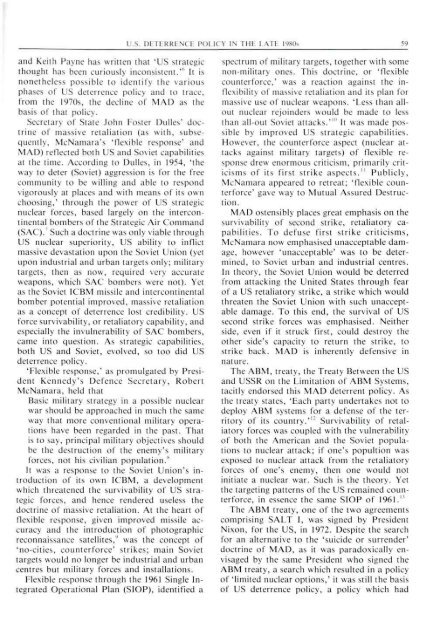ISSUE 76 : May/Jun - 1989 - Australian Defence Force Journal
ISSUE 76 : May/Jun - 1989 - Australian Defence Force Journal
ISSUE 76 : May/Jun - 1989 - Australian Defence Force Journal
- No tags were found...
Create successful ePaper yourself
Turn your PDF publications into a flip-book with our unique Google optimized e-Paper software.
U.S. DETERRENCE POLICY IN THE LATE 1980s 59and Keith Payne has written that 'US strategicthought has been curiously inconsistent.' 6 It isnonetheless possible to identify the variousphases of US deterrence policy and to trace,from the 1970s, the decline of MAD as thebasis of that policy.Secretary of State John Foster Dulles' doctrineof massive retaliation (as with, subsequently,McNamara's 'flexible response' andMAD) reflected both US and Soviet capabilitiesat the time. According to Dulles, in 1954, 'theway to deter (Soviet) aggression is for the freecommunity to be willing and able to respondvigorously at places and with means of its ownchoosing,' through the power of US strategicnuclear forces, based largely on the intercontinentalbombers of the Strategic Air Command(SAC). Such a doctrine was only viable throughUS nuclear superiority, US ability to inflictmassive devastation upon the Soviet Union (yetupon industrial and urban targets only; militarytargets, then as now, required very accurateweapons, which SAC bombers were not). Yetas the Soviet 1CBM missile and intercontinentalbomber potential improved, massive retaliationas a concept of deterrence lost credibility. USforce survivability, or retaliatory capability, andespecially the invulnerability of SAC bombers,came into question. As strategic capabilities,both US and Soviet, evolved, so too did USdeterrence policy.'Flexible response,' as promulgated by PresidentKennedy's <strong>Defence</strong> Secretary, RobertMcNamara, held thatBasic military strategy in a possible nuclearwar should be approached in much the sameway that more conventional military operationshave been regarded in the past. Thatis to say, principal military objectives shouldbe the destruction of the enemy's militaryforces, not his civilian population. KIt was a response to the Soviet Union's introductionof its own ICBM, a developmentwhich threatened the survivability of US strategicforces, and hence rendered useless thedoctrine of massive retaliation. At the heart offlexible response, given improved missile accuracyand the introduction of photographicreconnaissance satellites, 9 was the concept of'no-cities, counterforce' strikes; main Soviettargets would no longer be industrial and urbancentres but military forces and installations.Flexible response through the 1961 Single IntegratedOperational Plan (SIOP), identified aspectrum of military targets, together with somenon-military ones. This doctrine, or 'flexiblecounterforce,' was a reaction against the inflexibilityof massive retaliation and its plan formassive use of nuclear weapons. 'Less than alloutnuclear rejoinders would be made to lessthan all-out Soviet attacks.'"' It was made possibleby improved US strategic capabilities.However, the counterforce aspect (nuclear attacksagainst military targets) of flexible responsedrew enormous criticism, primarily criticismsof its first strike aspects." Publicly,McNamara appeared to retreat; 'flexible counterforce'gave way to Mutual Assured Destruction.MAD ostensibly places great emphasis on thesurvivability of second strike, retaliatory capabilities.To defuse first strike criticisms,McNamara now emphasised unacceptable damage,however 'unacceptable' was to be determined,to Soviet urban and industrial centres.In theory, the Soviet Union would be deterredfrom attacking the United States through fearof a US retaliatory strike, a strike which wouldthreaten the Soviet Union with such unacceptabledamage. To this end, the survival of USsecond strike forces was emphasised. Neitherside, even if it struck first, could destroy theother side's capacity to return the strike, tostrike back. MAD is inherently defensive innature.The ABM, treaty, the Treaty Between the USand USSR on the Limitation of ABM Systems,tacitly endorsed this MAD deterrent policy. Asthe treaty states, 'Each party undertakes not todeploy ABM systems for a defense of the territoryof its country.''" Survivability of retaliatoryforces was coupled with the vulnerabilityof both the American and the Soviet populationsto nuclear attack; if one's popultion wasexposed to nuclear attack from the retaliatoryforces of one's enemy, then one would notinitiate a nuclear war. Such is the theory. Yetthe targeting patterns of the US remained counterforce,in essence the same SIOP of 1961."The ABM treaty, one of the two agreementscomprising SALT I, was signed by PresidentNixon, for the US, in 1972. Despite the searchfor an alternative to the 'suicide or surrender'doctrine of MAD, as it was paradoxically envisagedby the same President who signed theABM treaty, a search which resulted in a policyof 'limited nuclear options,' it was still the basisof US deterrence policy, a policy which had
















